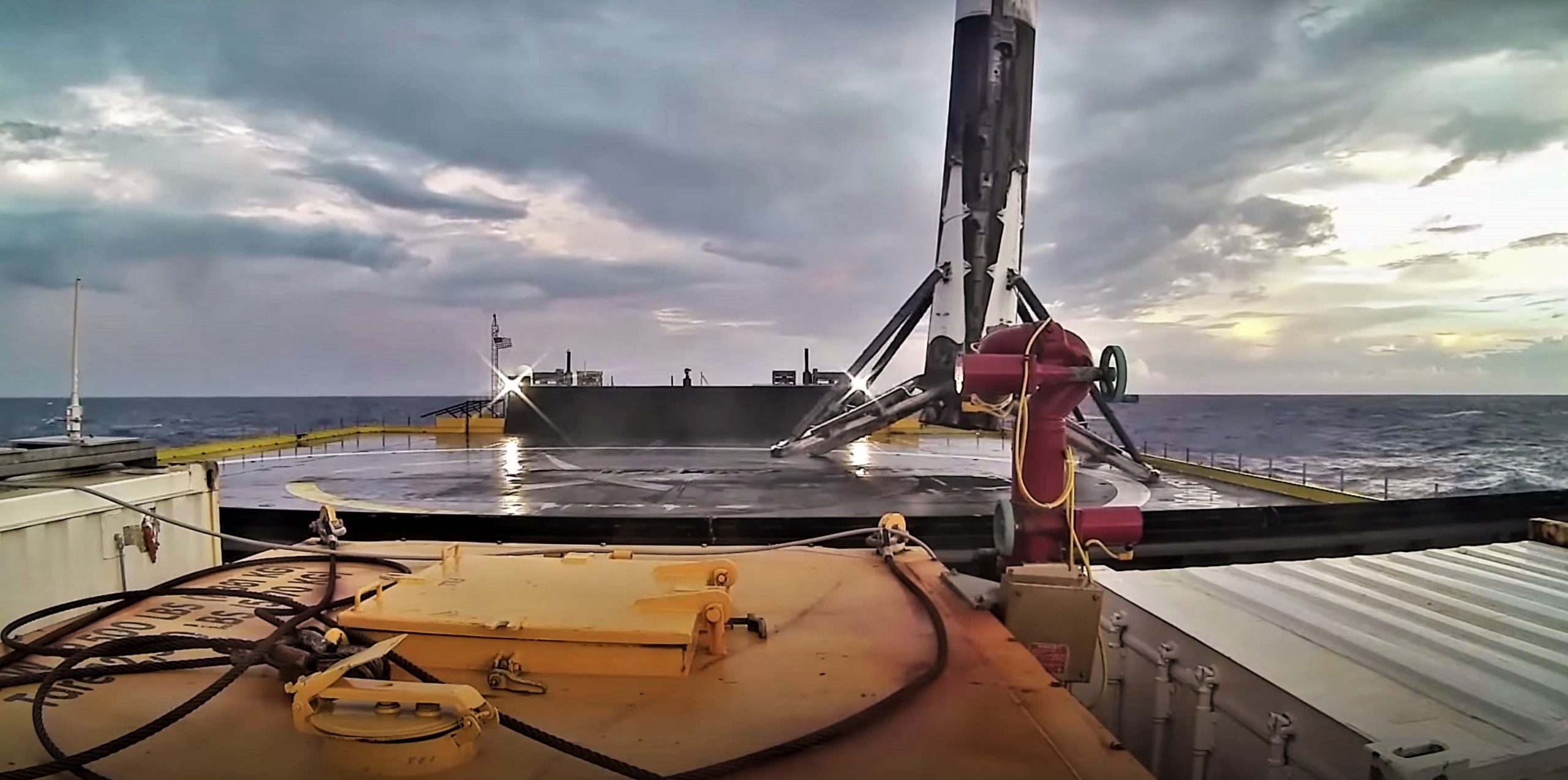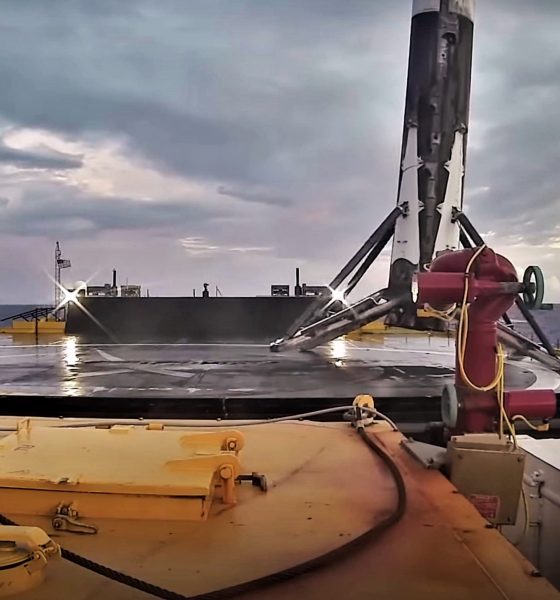

SpaceX
SpaceX’s Falcon 9 faced its most challenging reentry and landing yet
SpaceX has completed its second successful launch of 2019, sending the first commercial Moon lander on the first leg of its journey to the lunar surface with a sooty Falcon 9 Block 5 rocket.
Built by Israeli aerospace company IAI for customer SpaceIL, the Moon lander – named Beresheet, Hebrew for “in the beginning” – is just one of three payloads present on this launch, gently perched with Air Force satellite S5 atop Indonesian communications satellite PSN-6. According to SpaceX, Falcon 9 B1048’s third successful launch and landing faced the Block 5 booster with “some of the most challenging reentry conditions to date”.
https://twitter.com/_TomCross_/status/1098766636780261378
After separating from Falcon 9’s upper stage and payload at an altitude of 68 km (43 mi) and a velocity of nearly 2.4 km/s (1.5 mi/s, Mach 7+), B1048 continued on in the near-vacuum of suborbital space, likely peaking at 80-100 km before heading back down into the thicker parts of Earth’s atmosphere. Despite what one SpaceX engineer described as “the most challenging reentry conditions to date”, B1048 appeared to perform perfectly over the course of its third launch and landing.
According to SpaceX CEO Elon Musk, the booster could fly again as early as April in support of Crew Dragon’s in-flight abort mission, although his implication that that test will occur in April directly contradicts a recent NASA schedule update that pegged the test no earlier than (NET) June 2019.
Highest reentry heating to date. Burning metal sparks from base heat shield visible in landing video. Fourth relight scheduled for April. https://t.co/uq6TdMhgFN
— Elon Musk (@elonmusk) February 22, 2019
Shortly before the main PSN-6 satellite was deployed from Falcon 9’s upper stage, one of SpaceX’s launch network operators verbally confirmed that SpaceIL’s Beresheet lander had established communications with the ground and successfully deployed its landing legs in orbit, one tangible step closer to the first attempted commercial Moon landing. Beresheet and PSN-6 will now take opposite paths forward, with the lunar lander raising its orbit quite literally to the Moon while PSN-6 drops its high end down and circularizes at approximately 35,800 km (22,250 mi) above Earth.
Combined with Musk’s apparent belief that B1048 – having just experienced what he described as the “highest reentry heating to date” – could be ready to launch again as few as 40-70 days from now, this successful launch and landing of a flight-proven Falcon 9 booster (the second time a SpaceX rocket as flown for the third time) suggests that the Block 5 upgrade continues to operate nominally. Designed to radically improve the ease and speed of Falcon 9 booster reuse, Block 5 debuted in May 2018 and has now launched 12 times, with half of those missions flying on flight-proven boosters. The proportion of flight-proven to new booster launches is likely to continue to grow in 2019, ultimately reaching a point where new boosters are limited to inaugural hardware debuts or specific contractual requests from conservative US government customers.
https://twitter.com/_TomCross_/status/1098734999027752961?
Up next for SpaceX is the imminent orbital launch debut of Crew Dragon, set to occur no earlier than March 2nd. While a slip of several days or more is not out of the question, the lack of date movement less than ten days out from the target launch date suggests that this particular date is far more confident than the several that preceded it. Regardless, we’ll find out tomorrow just how confident NASA and SpaceX are in DM-1’s March 2nd launch plan.
Check out Teslarati’s newsletters for prompt updates, on-the-ground perspectives, and unique glimpses of SpaceX’s rocket launch and recovery processes!

News
SpaceX shades airline for seeking contract with Amazon’s Starlink rival

SpaceX employees, including its CEO Elon Musk, shaded American Airlines on social media this past weekend due to the company’s reported talks with Amazon’s Starlink rival, Leo.
Starlink has been adopted by several airlines, including United Airlines, Qatar Airways, Hawaiian Airlines, WestJet, Air France, airBaltic, and others. It has gained notoriety as an extremely solid, dependable, and reliable option for airline travel, as traditional options frequently cause users to lose connection to the internet.
Many airlines have made the switch, while others continue to mull the options available to them. American Airlines is one of them.
A report from Bloomberg indicates the airline is thinking of going with a Starlink rival owned by Amazon, called Leo. It was previously referred to as Project Kuiper.
American CEO Robert Isom said (via Bloomberg):
“While there’s Starlink, there are other low-Earth-orbit satellite opportunities that we can look at. We’re making sure that American is going to have what our customers need.”
Isom also said American has been in touch with Amazon about installing Leo on its aircraft, but he would not reveal the status of any discussions with the company.
The report caught the attention of Michael Nicolls, the Vice President of Starlink Engineering at SpaceX, who said:
“Only fly on airlines with good connectivity… and only one source of good connectivity at the moment…”
CEO Elon Musk replied to Nicolls by stating that American Airlines risks losing “a lot of customers if their connectivity solution fails.”
American Airlines will lose a lot of customers if their connectivity solution fails
— Elon Musk (@elonmusk) December 14, 2025
There are over 8,000 Starlink satellites in orbit currently, offering internet coverage in over 150 countries and territories globally. SpaceX expands its array of satellites nearly every week with launches from California and Florida, aiming to offer internet access to everyone across the globe.
Currently, the company is focusing on expanding into new markets, such as Africa and Asia.
News
Tesla hints at Starlink integration with recent patent
“By employing polymer blends, some examples enable RF transmission from all the modules to satellites and other communication devices both inside and outside the vehicle.”

Tesla hinted at a potential Starlink internet terminal integration within its vehicles in a recent patent, which describes a vehicle roof assembly with integrated radio frequency (RF) transparency.
The patent, which is Pub. No U.S. 2025/0368267 describes a new vehicle roof that is made of RF-transparent polymer materials, allowing and “facilitating clear communication with external devices and satellites.”
Tesla believes that a new vehicle roof design, comprised of different materials than the standard metallic or glass elements used in cars today, would allow the company to integrate modern vehicular technologies, “particularly those requiring radio frequency transmission and reception.
Tesla has recently filed a US patent application on integrating RF transparent materials into the roof structure.
“facilitating clear communication with external devices and satellites”
Tesla fleet is getting @Starlink connectivity integration soon. LFG @Tesla @elonmusk… pic.twitter.com/bLa8YtPLd1
— Chansoo Byeon (@Chansoo) December 9, 2025
Instead of glass or metallic materials, Tesla says vehicles may benefit from high-strength polymer blends, such as Polycarbonate, Acrylonitrile Butadiene Styrene, or Acrylonitrile Styrene Acrylate.
These materials still provide ideal strength metrics for crashworthiness, stiffness for noise, vibration, and harshness control, and are compliant with head impact regulations.
They would also enable better performance with modern technologies, like internet terminals, which need an uninterrupted signal to satellites for maximum reception. Tesla writes in the patent:
“By employing polymer blends, some examples enable RF transmission from all the modules to satellites and other communication devices both inside and outside the vehicle.”

One of the challenges Tesla seems to be aware of with this type of roof design is the fact that it will still have to enable safety and keep that at the forefront of the design. As you can see in the illustration above, Tesla plans to use four layers to increase safety and rigidity, while also combating noise and vibration.
It notes in the patent that disclosed examples still meet the safety requirements outlined in the Federal Motor Vehicle Safety Standards (FMVSS).
Starlink integrated directly into Tesla vehicles would be a considerable advantage for owners. It would come with a handful of distinct advantages.
Initially, the inclusion of Starlink would completely eliminate cellular dead zones, something that is an issue, especially in rural areas. Starlink would provide connectivity in these remote regions and would ensure uninterrupted service during road trips and off-grid adventures.
It could also be a critical addition for Robotaxi, as it is crucial to have solid and reliable connectivity for remote monitoring and fleet management.
Starlink’s growing constellation, thanks to SpaceX’s routine and frequent launch schedule, will provide secure, stable, and reliable internet connectivity for Tesla vehicles.
Although many owners have already mounted Starlink Mini dishes under their glass roofs for a similar experience, it may be integrated directly into Teslas in the coming years, either as an upgrade or a standard feature.
Investor's Corner
SpaceX IPO is coming, CEO Elon Musk confirms
However, it appears Musk is ready for SpaceX to go public, as Ars Technica Senior Space Editor Eric Berger wrote an op-ed that indicated he thought SpaceX would go public soon. Musk replied, basically confirming it.

Elon Musk confirmed through a post on X that a SpaceX initial public offering (IPO) is on the way after hinting at it several times earlier this year.
It also comes one day after Bloomberg reported that SpaceX was aiming for a valuation of $1.5 trillion, adding that it wanted to raise $30 billion.
Musk has been transparent for most of the year that he wanted to try to figure out a way to get Tesla shareholders to invest in SpaceX, giving them access to the stock.
He has also recognized the issues of having a public stock, like litigation exposure, quarterly reporting pressures, and other inconveniences.
However, it appears Musk is ready for SpaceX to go public, as Ars Technica Senior Space Editor Eric Berger wrote an op-ed that indicated he thought SpaceX would go public soon.
Musk replied, basically confirming it:
As usual, Eric is accurate
— Elon Musk (@elonmusk) December 10, 2025
Berger believes the IPO would help support the need for $30 billion or more in capital needed to fund AI integration projects, such as space-based data centers and lunar satellite factories. Musk confirmed recently that SpaceX “will be doing” data centers in orbit.
AI appears to be a “key part” of SpaceX getting to Musk, Berger also wrote. When writing about whether or not Optimus is a viable project and product for the company, he says that none of that matters. Musk thinks it is, and that’s all that matters.
It seems like Musk has certainly mulled something this big for a very long time, and the idea of taking SpaceX public is not just likely; it is necessary for the company to get to Mars.
The details of when SpaceX will finally hit that public status are not known. Many of the reports that came out over the past few days indicate it would happen in 2026, so sooner rather than later.
But there are a lot of things on Musk’s plate early next year, especially with Cybercab production, the potential launch of Unsupervised Full Self-Driving, and the Roadster unveiling, all planned for Q1.








